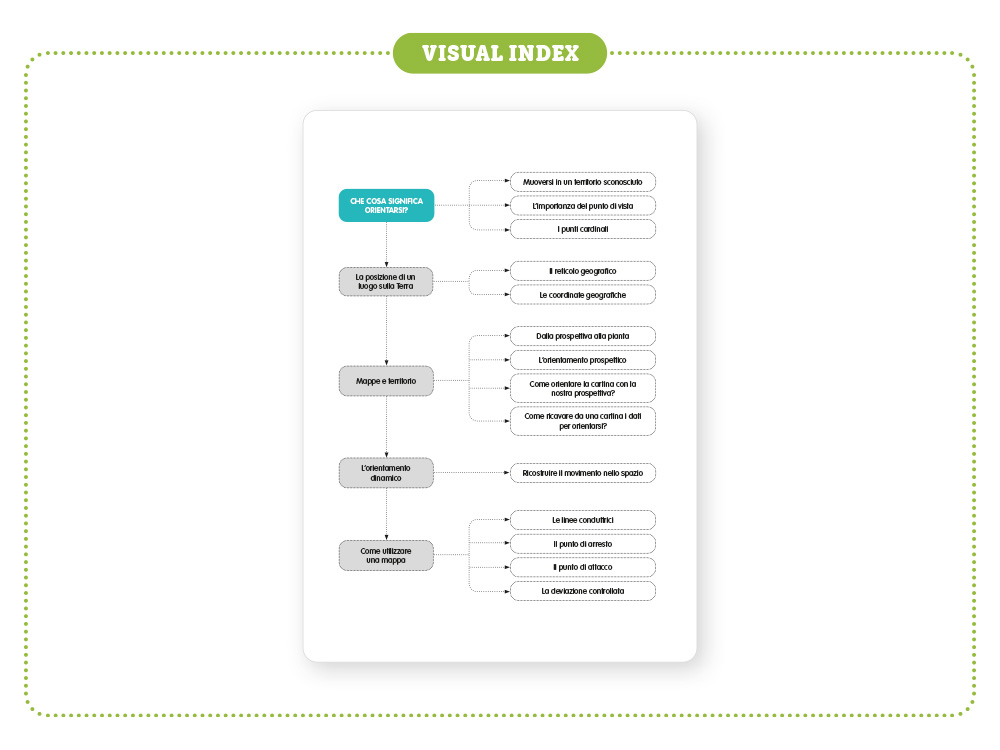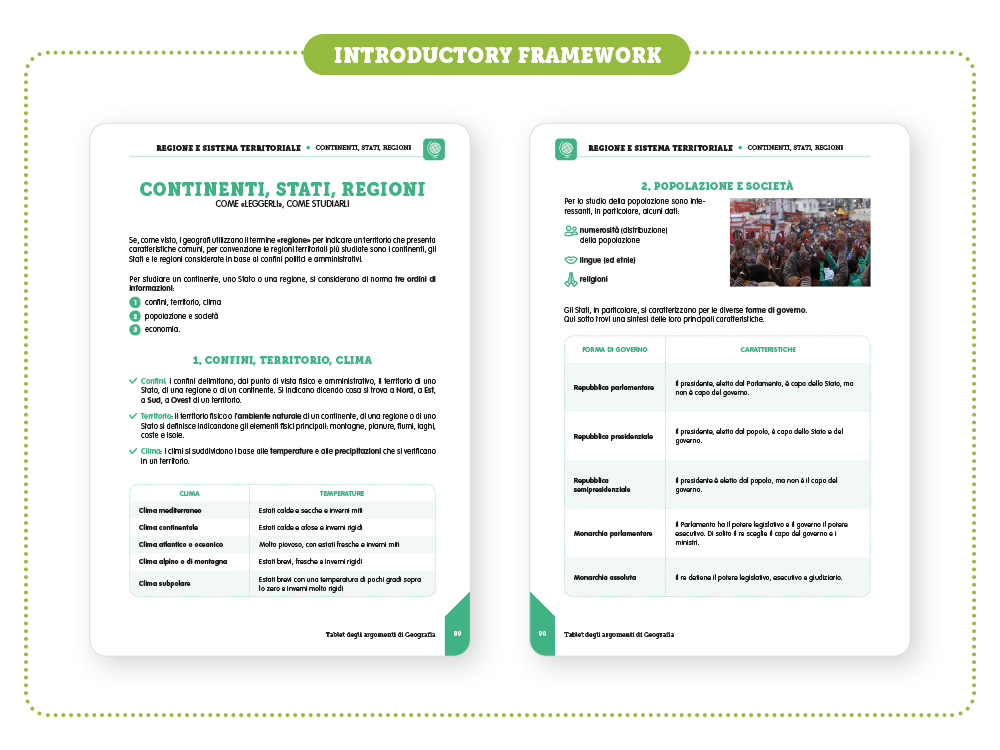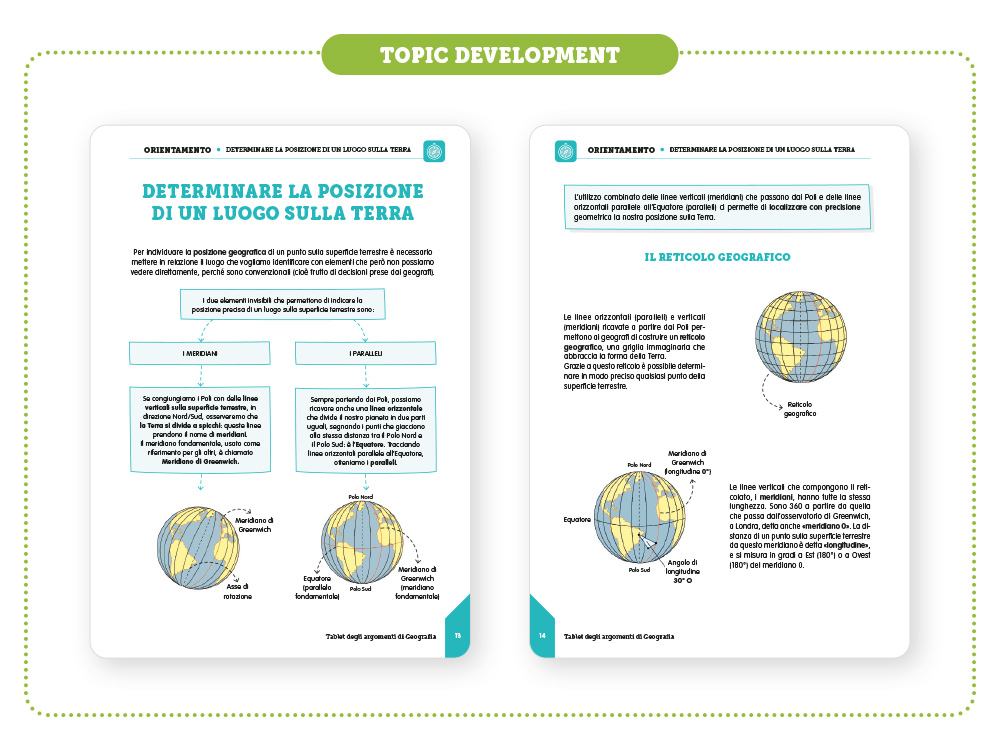 EN
EN
 PT
PT
Lower secondary school
Product: Book
Trim size in cm: 21x27cm
Pages: 216
ISBN: 9788859028994
Publication date: 01/11/2022
Suitable for: Lower secondary 1st level (ages 10-11), Lower secondary 2nd level (ages 12-13)
REQUEST A SAMPLE OR MORE INFORMATION
Designed to complement textbooks during the three years of lower secondary school and help children in the independent study of the geography programme and in the development of the basic skills of the discipline, Tablet of geography topics is an easy-to-consult tool, thanks to a clear and clean color graphic layout and the adoption of a vocabulary that is as simple and immediate as possible.
Also effective for pupils with Specific Learning Disorders.
The volume is divided into five sections: Orientation, The language of geography, The landscape, Regions and territorial systems and Geography and other disciplines.
Introduction
Orientation
What does it mean to orient yourself?
Determining the position of a place on Earth
Maps and territories
Dynamic orientation
How to use a map
The languages of geography
What is geography
A "hinge" discipline
What is a geographical map
Representing is approximating
A brief history of maps
Classifying geographical maps
Paper maps and digital maps
The data of geography
The landscape
What is a landscape
Elements of the landscape
Landscape protection
Regions and territorial systems
The geographic region
Continents, states, regions
Italy and its regions
Continents and States
Europe
Asia
Africa
Anglo-Saxon America
Latin America
Oceania
Antarctica
The Arctic
Geography and other disciplines
One discipline, many disciplines
Geography and the sciences
Human geography
Geography and economics

Lower secondary school
The volume proposes the geography programme of the lower secondary school, explained in a concise and functional way.
Like a real tablet, practical and easy to handle, where all information can be instantly recalled with a simple touch, the Tablet of Geography Topics presents five areas of knowledge: Orientation, the Language of geography, the Landscape, Regions and territorial systems, and Disciplines related to geography.
A tool designed to support textbooks during the three-year period of lower secondary school and to help students with self-study and in the development of the basic skills of the discipline.
Easy to consult, thanks to a clear and clean colour graphic setting and the adoption of vocabulary that is as simple and immediate as possible. It is an indispensable tool for all lower secondary school students, for teachers and for parents, and can be very effective for students with specific learning disabilities.
Structure of the book
The volume is divided into five sections, four of which respond more directly to the learning objectives upon completion of the third year of lower secondary school, to offer a broad coverage of the essential topics for optimal mastery of the subject over the three years:
The fifth section, Geography and other disciplines, completes the coverage with an in-depth analysis of the disciplines (astronomy, economics, geology, etc.) that geography uses to investigate the phenomena it studies.
The topics are treated in such a way as to be easily adapted to different teaching methodologies as well as to the different books in adoption. In addition, the Tablet of geography topics offers immediate and easy-to-use help.
Organization of sections
Each section is organized on three levels of access to the topics, ranging from general to particular for an ever more in-depth and articulated development and explanation of the topic covered.

Visual index
A detailed index of the contents and a visual map that anticipates the connections between the themes and their development, as a useful summary diagram and navigation tool for the section.

Introductory framework
An introductory framework represents another level of access to the topic of the section with definitions and general data for a better understanding of the more specific topics that will be covered later.

Topic development
The individual topics that, intertwined and interconnected, make up the field of knowledge are explored with the help of maps, icons, significant images, boxes, schemes and the use of a clear and simple vocabulary.
Leaf through some selected pages from the book that have been translated into English to facilitate your evaluation:
The Authors
Giulia Andrian Graduated in Literature and Philosophy from the University of Padua with a thesis in Regional Geography. At the Free University of Bolzano, she specialized in teaching for the I and II level secondary school and for Support. She worked for many years in the private sector and since 2006 she has been a teacher of Literature in lower secondary school. She collaborates with Erickson for the adaptation of history and geography textbooks for students with SLD and SEN; she has written teacher guides for inclusive education and workbooks with skills workshops for pupils. As a trainer and speaker, she has participated in various courses and conferences related to the teaching of geography.
Luisa Fazzini She has been a literature teacher in lower secondary school since 2001. In recent years she has chosen to devote herself to teaching geography. She is involved in training, she has won two regional ARPAV school awards for environmental planning, is a member of the Veneto regional board of AIIG (Italian Association of Geography Teachers) and contact person for education for Slow Food Veneto. For the magazine «Erodoto 108», she edits the online section «Geografica: The didactics of wonder".
Alessandro Morandini With a degree in Classical Literature with a thesis on Methodology and Techniques of Archaeological Research, he specialized in Prehistory and Protohistory at the University of Padua in 2007. Today he is a secondary school Literature teacher. In teaching practice, he transfers the interest in the study of landscapes in a geographical, historical and literary way. Game trainer at Erickson since 2019, he integrates teaching activities with playful teaching.